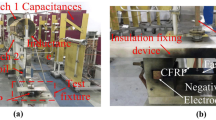Abstract
To clarify the evolution of damage for typical carbon woven fabric/epoxy laminates exposed to lightning strike, artificial lightning testing on carbon woven fabric/epoxy laminates were conducted, damage was assessed using visual inspection and damage peeling approaches. Relationships between damage size and action integral were also elucidated. Results showed that damage appearance of carbon woven fabric/epoxy laminate presents circular distribution, and center of the circle located at the lightning attachment point approximately, there exist no damage projected area dislocations for different layers, visual damage territory represents maximum damage scope; visible damage can be categorized into five modes: resin ablation, fiber fracture and sublimation, delamination, ablation scallops and block-shaped ply-lift; delamination damage due to resin pyrolysis and internal pressure exist obvious distinguish; project area of total damage is linear with action integral for the same type specimens, that of resin ablation damage is linear with action integral, but no correlation with specimen type, for all specimens, damage depth is linear with logarithm of action integral. The coupled thermal–electrical model constructed is capable to simulate the ablation damage for carbon woven fabric/epoxy laminates exposed to simulated lightning current through experimental verification.

















Similar content being viewed by others
References
Glover, B.M.: History of development of commercial aircraft and 787 dreamliner. Aviat. Eng. 592, 16–21 (2004)
Uman, M.A., Rakov, V.A.: The interaction of lightning with airborne vehicles. Prog. Aerosp. Sci. 39, 61–81 (2003)
Gagne, M., Therriault, D.: Lightning strike protection of composites. Prog. Aerosp. Sci. 64, 1–16 (2014)
NASA-Industry-FAA: In: Ed, R., Ed, R, (eds) Lightning Direct Effects Handbook. Lightning Technologies Inc, Pittsfied (2002)
Hirano, Y., Katsumata, S., Iwahori, Y.: Artificial lightning on graphite/epoxy composite laminate. Compos. Part A. 41, 1461–1470 (2010)
Feraboli, P., Miller, M.: Damage resistance and tolerance of carbon/epoxy composite coupons subjected to simulated lightning strike. Compos. Part A. 40, 954–967 (2009)
Feraboli, P., Kawakami, H.: Damage of carbon/epoxy composite plates subjected to mechanical impact and simulated lightning. J. Aircraft. 47, 999–1012 (2010)
Wang, F.S., Ji, Y.Y., Yu, X.S.: Ablation damage assessment of aircraft carbon fiber/epoxy composite and its protection structures suffered from lightning strike. Compos. Struct. 145, 226–241 (2016)
Ogasawara, T., Hirano, Y., Yoshimura, A.: Coupled thermal–electrical analysis for carbon fiber/epoxy composites exposed to simulated lightning current. Compos. Part A. 41, 973–983 (2010)
Abdelal, G., Murphy, A.: Nonlinear numerical modeling of lightning strike effect on composite panels with temperature dependent material properties. Compos. Struct. 109, 268–278 (2014)
Wang, F.S., Ding, N., Liu, Z.Q.: Ablation damage characteristic and residual strength prediction of carbon fiber/epoxy composite suffered from lightning strike. Compos. Struct. 117, 222–233 (2014)
Dong, Q., Guo, Y.L., Sun, X.C.: Coupled electrical-thermal-pyrolytic analysis of carbon fiber/epoxy composites subjected to lightning strike. Polymer. 56, 385–394 (2015)
Dong, Q., Guo, Y.L., Chen, J.L.: Influencing factor analysis based on electrical–thermal-pyrolytic simulation of carbon fiber composites lightning damage. Compos. Struct. 140, 1–10 (2016)
Yin, J.J., Li, S.L., Chang, F.: Ablation damage characteristic analysis of composite laminate with fastener subjected to lightning strike. Appl. Compos. Mater. 23, 821–837 (2016)
Li, S.L., Yin, J.J., Yao, X.L.: Damage analysis for carbon fiber/epoxy composite exposed to simulated lighting current. J Reinf plast comp. 35, 1201–1213 (2016)
Li, Y.C., Li, R.F., Lai, H.: Effect of hygrothermal aging on the damage characteristics of carbon woven fabric/epoxy laminates subjected to simulated lightning strike. Mater Design. 99, 477–489 (2016)
Li, Y.C., Li, R.F., Lu, L.Y.: Experimental study of damage characteristics of carbon woven fabric/epoxy laminates subjected to lightning strike. Compos. Part A. 79, 164–175 (2015)
Standard test method for measuring the damage resistance of a fiber reinforced polymer matrix composite to a drop-weight impact event. ASTM D7136M-07. American Society for Testing and Materials (ASTM), West Conshohocken, PA, USA (2007)
Test method for tensile properties of orientation fiber reinforced polymer matrix composite materials. GB/T 3354–2014. Standardization Administration of the People’s Republic of China (SAC) (2015)
SAE-ARP-5412A, Aircraft lightning environment and related test waveforms. SAE International, (2005)
Abaqus: Users’Manual, version 6.14. ABAQUS, Inc. (2014)
Fanucci, J.: Thermal response of radiantly heated Kevlar and graphite/epoxy composites. J. Compos. Mater. 21, 129–139 (1987)
Griffis, C.A., Nemes, J.A., Stronesifer, F.R., Chang, A.I.: Degradation in strength of laminated composites subjected to intense heating and mechanical loading. J. Compos. Mater. 20, 216–235 (1986)
Wang, Y.Q., Zhupanska, O.I.: Thermal Ablation in Fiber-Reinforced Composite Laminates Subjected to Continuing Lightning Current. 57th AIAA/ASCE/AHS/ASC Structures, structural dynamics, and materials conference, San Diego, California, 1–17, Jan 2016
Bai, Y., Keller, T., Vallee, T.: Modeling of thermo-physical properties and thermal responses for FRP composites in fire. Asia-Pacific Conference on FRP in Structures. APFIS, 645–650, 2007
Lee, J.H., Kim, K.S., Kim, H.: Determination of kinetic parameters during the thermal decomposition of epoxy/carbon fiber composite material. Korean J. Chem. Eng. 30, 955–962 (2013)
Acknowledgements
This study is supported by the National Natural Science Foundation (No: 51477132).
Author information
Authors and Affiliations
Corresponding author
Rights and permissions
About this article
Cite this article
Yin, J.J., Chang, F., Li, S.L. et al. Experimental and Numerical Simulation Analysis of Typical Carbon Woven Fabric/Epoxy Laminates Subjected to Lightning Strike. Appl Compos Mater 24, 1353–1372 (2017). https://doi.org/10.1007/s10443-017-9588-6
Received:
Accepted:
Published:
Issue Date:
DOI: https://doi.org/10.1007/s10443-017-9588-6




